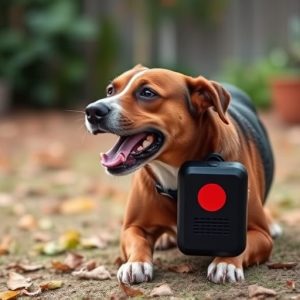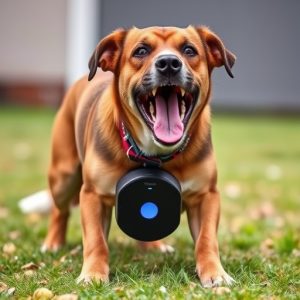Stationary vs Mobile Dog Repellents: Choosing the Right Gear
Dog repellent gear offers both positive reinforcement and correction methods, with stationary and mo…….
Dog repellent gear offers both positive reinforcement and correction methods, with stationary and mobile types. Stationary devices, ideal for securing perimeters, emit sounds, scents, or visuals to deter dogs consistently, enhancing traditional training with consistent protection and minimal maintenance. Mobile repellents, portable for walks or training, provide flexibility by allowing users to manage range and coverage, making them suitable for outdoor activities or rearranging spaces. The choice between these options depends on usage context: stationary for targeted areas, mobile for dynamic interactions during walks or training.
“Unleash a world of safe, effective dog training with ultrasonic repellent gear. This comprehensive guide delves into the heart of canine behavior modification, exploring stationary and mobile options for optimal results. From understanding various types to comparing stationary vs. mobile designs, we demystify these tools. Learn about their unique advantages, applications, best practices, and how to choose the perfect fit for your dog’s specific needs and environment, ensuring a harmonious training experience.”
- Understanding Dog Repellent Gear: Types and Their Functionality
- Stationary Dog Repellents: Advantages, Applications, and Best Practices
- Mobile Dog Repellents: Portability, Flexibility, and Effectiveness in Different Scenarios
- Comparative Analysis: Choosing the Right Repellent Gear for Your Dog's Behavior and Environment
Understanding Dog Repellent Gear: Types and Their Functionality
Dog repellent gear is a vast category designed to address various canine behaviors, offering both positive reinforcement and correction methods. These tools can be broadly categorized into two main types: stationary and mobile repellents. Stationary devices are typically installed in specific areas to deter dogs from entering or staying in those spaces. They often use sound, scent, or visual cues to achieve this, such as ultrasonic noise generators that emit high-frequency sounds not audible to humans but unpleasant for dogs. On the other hand, mobile repellents are portable and designed to be carried by a person, allowing for dynamic interaction during walks or training sessions. These devices can use similar technology as their stationary counterparts but also often incorporate adjustable settings, allowing users to customize intensity levels based on behavior and environment.
When considering a stationary vs. mobile dog repellent comparison, understanding the context of usage is key. Stationary options are ideal for securing perimeters around gardens or specific areas in your home, while mobile repellents excel during walks or training where immediate feedback and adjustability are beneficial. Both types leverage modern technology to enhance traditional training methods, ensuring a more effective and humane approach to managing canine behavior.
Stationary Dog Repellents: Advantages, Applications, and Best Practices
Stationary dog repellents offer several advantages over mobile options in terms of stationary vs mobile dog repellent comparison. Firstly, they provide consistent protection, as they are fixed in one location and can be designed to emit sounds or release scents that deter dogs at all times. This is particularly beneficial for protecting specific areas like gardens, patios, or even entire homes from unwanted canine visitors. Moreover, stationary devices are generally more environmentally friendly since they don’t require frequent battery replacements or refilling.
Their applications are diverse, ranging from residential properties to commercial spaces like farms and parks. For instance, in rural areas, stationary repellents can help protect crops and livestock from dogs, while urban dwellers might use them to keep dogs away from specific streets or public spaces. Best practices involve strategically placing the devices where dog activity is most common, ensuring proper placement for maximum coverage and minimal environmental impact. Additionally, combining stationary repellents with positive reinforcement training can significantly enhance their effectiveness.
Mobile Dog Repellents: Portability, Flexibility, and Effectiveness in Different Scenarios
Mobile dog repellents offer a unique advantage in terms of portability and flexibility, setting them apart from their stationary counterparts. Their compact design allows for easy transportation, making them ideal for outdoor adventures, travel, or even just moving around your property. Whether you’re at a park, on a hike, or simply rearranging your living space, mobile repellents provide the convenience of protection without the hassle of permanent installation.
When comparing stationary and mobile dog repellents, effectiveness remains consistent as both types utilize similar ultrasonic technology to deter dogs. However, mobility allows users to actively manage and adjust the repellent’s range and coverage based on specific scenarios. This dynamic approach ensures that the repellent can adapt to changing environments, providing tailored protection for various settings, from backyards to wilderness trails.
Comparative Analysis: Choosing the Right Repellent Gear for Your Dog's Behavior and Environment
When it comes to dog training and addressing unwanted behaviors, ultrasonic repellent gear has emerged as a popular tool. However, not all repellents are created equal. A crucial aspect to consider is the choice between stationary and mobile devices, tailored to your dog’s behavior and environment.
Stationary repellent systems are ideal for consistent, targeted training in specific areas like homes or cars. These devices emit high-frequency sound waves that are unpleasant to dogs, encouraging them to avoid certain spaces. On the other hand, mobile repellents offer versatility, perfect for outdoor training sessions or when traveling with your dog. They can be easily carried and deployed in various locations, making them suitable for addressing behavioral issues during walks or in unfamiliar environments. The choice depends on your dog’s needs—whether it requires focused, localized training or a more flexible approach to deterring unwanted behaviors across different settings.
When it comes to training your dog, both stationary and mobile ultrasonic repellent gear offer effective solutions. Understanding their unique advantages is key to making an informed decision based on your dog’s behavior and environment. A stationary repellent can be a game-changer for managing specific areas, while mobile options provide flexibility during outdoor walks or travel. In the end, a thoughtful comparison between these types allows you to choose the right gear, fostering a harmonious relationship with your canine companion. Remember, the ideal choice lies in matching the appropriate technology with your dog’s needs and preferences, ensuring successful training outcomes.


